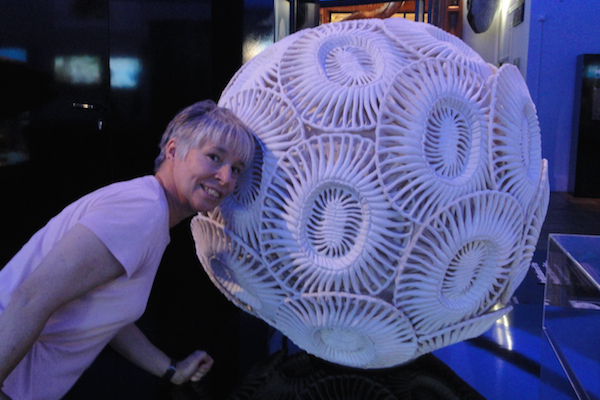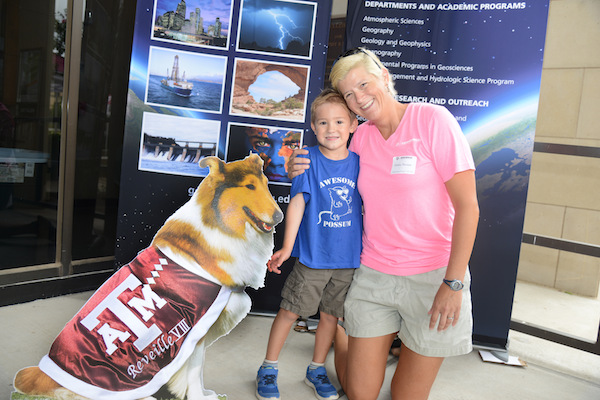Rocking the boat
Dec 11, 2014
Magazine marks years of progress for women in oceanography.
 Dr. Mary Jo Richardson
Dr. Mary Jo Richardson Dr. Debbie Thomas
Dr. Debbie Thomas Darren Henrichs, Sílvia Anglès, Dr. Lisa Campbell, Darcie Ryan, McKensie Daugherty
Darren Henrichs, Sílvia Anglès, Dr. Lisa Campbell, Darcie Ryan, McKensie Daugherty Eight Texas A&M-affiliated oceanographers are featured in a special supplement of Oceanography, the magazine of the Oceanography Society. “Women in Oceanography: A Decade Later” looks at the progress made in the traditionally male-dominated discipline with more than 200 autobiographical essays that express the scientists’ triumphs and challenges during the 10 years since the first supplement was printed in 2005. Other articles also refer to Texas A&M, in particular women’s roles in scientific ocean drilling.
The three College of Geosciences faculty members featured are Lisa Campbell, professor, Departments of Oceanography and Biology; Mary Jo Richardson, Regents’ Professor of Oceanography; and Debbie Thomas, associate professor and oceanography department head.
Each of these faculty members have made substantial contributions in helping mentor junior faculty, and undergraduate and graduate students, raising the profile of women in the discipline, and securing scholarships and other funds to help students enter and thrive in the geosciences.
For example, in addition to managing her own laboratory and research in analyzing harmful algal blooms, Campbell points with pride in her essay to her commitment to mentoring and promoting women faculty.
“Looking back, I can count more than 60 undergraduates, graduate students, and postdoctoral fellows who have worked in my laboratory, a majority of them women,” she writes.
Richardson serves as co-chair of the Workplace Climate Change, part of the university’s ADVANCE program to increase representation and advancement of women in science and engineering careers. She has also been successful in obtaining grants from the NSF Scholarships in STEM initiative, helping more than 120 undergraduates and graduates achieve degrees in geosciences. She concludes her essay by noting: “In the last 10 years, I am pleased and proud to have been able to provide opportunities for students, junior colleagues, and peers that were not available to me.”
Thomas looks back at the last 10 years in wonder. She began as an assistant professor and in the intervening years built a lab with her husband, Brent Miller, a geologist, and gave birth to their son, Van. She is now department head and a candidate for full professor.
“I find it crazy to think that over the past 10 years I’ve evolved from an early career scientist into a leadership role,” Thomas writes. “I now fully recognize that as women in the ocean sciences, we must all serve as mentors and leaders at every stage in our careers in order to broaden future opportunities for girls and women.”
Past, present and future
The five other essays written by women connected to Texas A&M include two former students, a current researcher and two future faculty members.
Paula Bontempi ’95 is an ocean biology and biochemistry program specialist at NASA in Washington, D.C. While obtaining her master’s degree from Texas A&M, she also worked at GERG.
Ashanti Johnson ’93, ’99, a chemical oceanographer, was the first African American student to receive a doctorate in oceanography from Texas A&M. She is currently assistant vice provost for faculty recruitment and associate professor of environmental science at the University of Texas at Arlington. During her career, Johnson has been at the forefront in breaking down barriers for women and minorities in STEM fields. Her numerous awards include a Presidential Award for Excellence in Science, Mathematics and Engineering Mentoring and recognition as one of NBC’s 100 History Makers in the Making.
Kristen Thyng is a post-doctoral research associate in the oceanography department.
She says oceanography is a good fit for her unusual background, which includes degrees in physics, applied mathematics and mechanical engineering.
Jessica Fitzsimmons, currently a postdoctoral research associate at Rutgers University, is a biogeochemist who begins this summer as assistant professor in the Department of Oceanography. In her essay, Fitzsimmons says she has been overwhelmed by the Texas A&M and the department’s welcoming attitude and willingness to help place her husband, a sociologist.
“The family-friendly attitude shown at TAMU is a big step forward for academia, with effects that will hopefully trickle down through my students, my teaching, and my science,” she writes.
Masako Tominaga ’05, ’09, a marine geophysicist, received her graduate degrees in oceanography and is returning to Texas A&M as an assistant professor in the Department of Geology and Geophysics.
Women at sea
Other references to Texas A&M include the article “Women in Oceanography: Continuing Challenges.” With a 50-50 ratio of female to male students, the Department of Oceanography compares favorably with 25 other oceanographic institutions. At the assistant and associate professor level, the percentages of female faculty members are 100% and 50%, respectively, but only 14% for full professors.
In her article, “Women of the Academy and the Sea: 2000–2014,” Suzanne O’Connell, professor in the Department of Earth and Environmental Sciences at Wesleyan University and former staff scientist in the Ocean Drilling Program (ODP) at Texas A&M, traces women scientists’ shipboard participation in scientific ocean drilling, beginning on Glomar Challenger with the original Deep Sea Drilling Project to the three programs at Texas A&M, which is science operator for JOIDES Resolution, drillship for the International Ocean Discovery Program.
“There are over 100 graduate student and early career women with shipboard scientific drilling experience who should be encouraged to take a leadership role in planning the future of scientific ocean drilling,” O’Connell concludes.
In a news release, the Oceanography Society notes that although progress during the last decade has achieved parity in numbers of men and women graduate students, men continue to outnumber women at other levels, especially in leadership positions and representation among senior faculty. Reports like these, the organization concludes, help bring attention to the issue and identify areas where improvements can be made.

